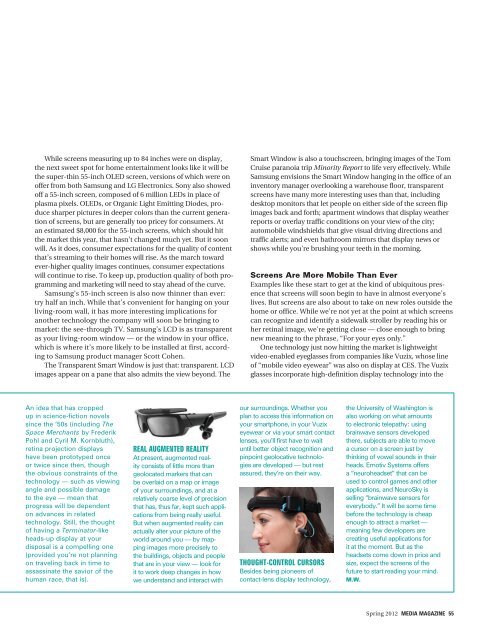THIRD ANNUAL SCREENS ISSUE - MediaPost
THIRD ANNUAL SCREENS ISSUE - MediaPost
THIRD ANNUAL SCREENS ISSUE - MediaPost
Create successful ePaper yourself
Turn your PDF publications into a flip-book with our unique Google optimized e-Paper software.
While screens measuring up to 84 inches were on display,<br />
the next sweet spot for home entertainment looks like it will be<br />
the super-thin 55-inch OLED screen, versions of which were on<br />
offer from both Samsung and LG Electronics. Sony also showed<br />
off a 55-inch screen, composed of 6 million LEDs in place of<br />
plasma pixels. OLEDs, or Organic Light Emitting Diodes, produce<br />
sharper pictures in deeper colors than the current generation<br />
of screens, but are generally too pricey for consumers. At<br />
an estimated $8,000 for the 55-inch screens, which should hit<br />
the market this year, that hasn’t changed much yet. But it soon<br />
will. As it does, consumer expectations for the quality of content<br />
that’s streaming to their homes will rise. As the march toward<br />
ever-higher quality images continues, consumer expectations<br />
will continue to rise. To keep up, production quality of both programming<br />
and marketing will need to stay ahead of the curve.<br />
Samsung’s 55-inch screen is also now thinner than ever:<br />
try half an inch. While that’s convenient for hanging on your<br />
living-room wall, it has more interesting implications for<br />
another technology the company will soon be bringing to<br />
market: the see-through TV. Samsung’s LCD is as transparent<br />
as your living-room window — or the window in your office,<br />
which is where it’s more likely to be installed at first, according<br />
to Samsung product manager Scott Cohen.<br />
The Transparent Smart Window is just that: transparent. LCD<br />
images appear on a pane that also admits the view beyond. The<br />
An idea that has cropped<br />
up in science-fiction novels<br />
since the ’50s (including The<br />
Space Merchants by Frederik<br />
Pohl and Cyril M. Kornbluth),<br />
retina projection displays<br />
have been prototyped once<br />
or twice since then, though<br />
the obvious constraints of the<br />
technology — such as viewing<br />
angle and possible damage<br />
to the eye — mean that<br />
progress will be dependent<br />
on advances in related<br />
technology. Still, the thought<br />
of having a Terminator-like<br />
heads-up display at your<br />
disposal is a compelling one<br />
(provided you’re not planning<br />
on traveling back in time to<br />
assassinate the savior of the<br />
human race, that is).<br />
REAL AUGMENTED REALITY<br />
At present, augmented reality<br />
consists of little more than<br />
geolocated markers that can<br />
be overlaid on a map or image<br />
of your surroundings, and at a<br />
relatively coarse level of precision<br />
that has, thus far, kept such applications<br />
from being really useful.<br />
But when augmented reality can<br />
actually alter your picture of the<br />
world around you — by mapping<br />
images more precisely to<br />
the buildings, objects and people<br />
that are in your view — look for<br />
it to work deep changes in how<br />
we understand and interact with<br />
Smart Window is also a touchscreen, bringing images of the Tom<br />
Cruise paranoia trip Minority Report to life very effectively. While<br />
Samsung envisions the Smart Window hanging in the office of an<br />
inventory manager overlooking a warehouse floor, transparent<br />
screens have many more interesting uses than that, including<br />
desktop monitors that let people on either side of the screen flip<br />
images back and forth; apartment windows that display weather<br />
reports or overlay traffic conditions on your view of the city;<br />
automobile windshields that give visual driving directions and<br />
traffic alerts; and even bathroom mirrors that display news or<br />
shows while you’re brushing your teeth in the morning.<br />
Screens Are More Mobile Than Ever<br />
Examples like these start to get at the kind of ubiquitous presence<br />
that screens will soon begin to have in almost everyone’s<br />
lives. But screens are also about to take on new roles outside the<br />
home or office. While we’re not yet at the point at which screens<br />
can recognize and identify a sidewalk stroller by reading his or<br />
her retinal image, we’re getting close — close enough to bring<br />
new meaning to the phrase, “For your eyes only.”<br />
One technology just now hitting the market is lightweight<br />
video-enabled eyeglasses from companies like Vuzix, whose line<br />
of “mobile video eyewear” was also on display at CES. The Vuzix<br />
glasses incorporate high-definition display technology into the<br />
our surroundings. Whether you<br />
plan to access this information on<br />
your smartphone, in your Vuzix<br />
eyewear or via your smart contact<br />
lenses, you’ll first have to wait<br />
until better object recognition and<br />
pinpoint geolocative technologies<br />
are developed — but rest<br />
assured, they’re on their way.<br />
THOUGHT-CONTROL CURSORS<br />
Besides being pioneers of<br />
contact-lens display technology,<br />
the University of Washington is<br />
also working on what amounts<br />
to electronic telepathy: using<br />
brainwave sensors developed<br />
there, subjects are able to move<br />
a cursor on a screen just by<br />
thinking of vowel sounds in their<br />
heads. Emotiv Systems offers<br />
a “neuroheadset” that can be<br />
used to control games and other<br />
applications, and NeuroSky is<br />
selling “brainwave sensors for<br />
everybody.” It will be some time<br />
before the technology is cheap<br />
enough to attract a market —<br />
meaning few developers are<br />
creating useful applications for<br />
it at the moment. But as the<br />
headsets come down in price and<br />
size, expect the screens of the<br />
future to start reading your mind.<br />
M.W.<br />
Spring 2012 MEDIA MAGAZINE 55








